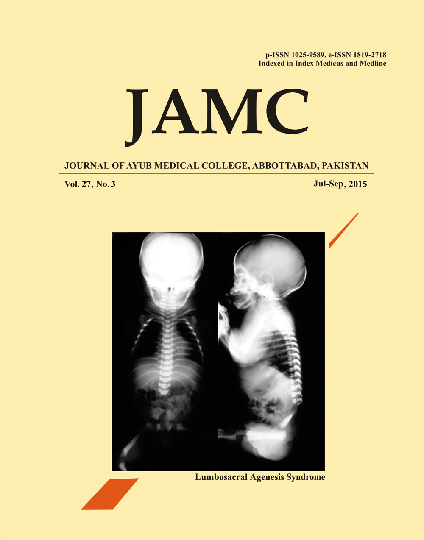THE KNOCKED-OUT UNILATERAL KIDNEY! CAUSES AND PRESENTATION
Abstract
Background: Due to lack of awareness and non-availability of proper medical facilities in Pakistan, patients with kidney problems tend to seek urological consultation very late when their kidney has already knocked-out. The aim of the study was to find the various presenting complaints of patients having unilateral loss of kidney function and their aetiologies. The study also targeted the patient’s awareness regarding their disease. Methods: This descriptive case-series of 103 consecutive patients who were diagnosed as having less than 20% of function on DTPA Renal Scan were evaluated. The aetiology of the non-functioning kidney (NFK) was made on either imaging findings or during the exploration, and/or on histopathology if necessary. The results were analysed using SPSS 16.0. Results: The aetiology of the unilateral renal failure included those that were secondary to nephro-pelvic stones in 39.8% and ureteric stones in 14.6%. Of the other aetiologies culminating in a unilateral NFK, 7.8% of the patients had chronic pyelonephritis, 20.4 % had PUJO and 5.8% were Genito-urinary Tuberculosis; 3.9% had VUR and were found incidentally, 3.9% developed non-functioning kidney iatrogenically. About 39.8% of the patients knew about their primary disease causing destruction of renal function since long. The remaining 60.2% were unaware that they had developed NFK already when they presented. Conclusion: Proper education through awareness program both for the public and general practitioners can detect early threats to the kidney and hence decrease the loss of a kidney. This will also decrease the number of nephrectomies carried out for the benign conditions.References
Datta B, Moitra T, Chaudhury DN, Halder B. Analysis of 88 nephrectomies in a rural tertiary care centre of India. Saudi J Kidney Dis Transpl 2012:23(2):409–13.
Gluhovschi G, Gadalean F, Gluhovschi C, Petrica L, Velciov S, Gluhovschi A et al. The solitary kidney—a nephrological perspective. Rom J Intern Med 2013;51(2):80–8.
Ghalayini IF. Pathological spectrum of nephrectomies in a general hospital. Asian J Surg 2002;25(2):163–9.
Rafique M. Nephrectomy: indications, complications and mortality in 154 consecutive patients. J Pak Med Assoc 2007;57(6):6;308–11.
Shah HN, Jain P, Chibber PJ. Laparoscopic nephrectomy for giant staghorn calculus with non-functioning kidneys: Is associated unsuspected urothelial carcinoma responsible for conversion? Report of 2 cases. BMC Urol 2006;6:1.
Binayke R, Sisodia SM. Tuberculosis and incidental tubulopapillary adenoma in a nephrectomy specimen. Bombay Hosp J 2011;53(2):223–5.
Beisland C, Medby PC, Sander S, Beisland HO. Nephrectomy – Indications, Complications and Postoperative Mortality in 646 Consecutive Patients. Eur Urol 2000;37(1):58–64.
Rafique M, Bhutta RA, Rauf A, Chaudhry IA. Chemical composition of upper renal tract calculi in Multan. J Pak Med Assoc 2000;50(5):145–8.
Bangash K, Shigri F, Jamal A, Anwar K. Spectrum of Renal Stones Composition; Chemical Analysis of Renal Stones. Int J Pathol 2011;9(2):2;63–6.
Talati J. Management of renal stones by operation. In "The Management of Lithiasis: The rationale development of technology". Talati J, Sutton RAL, Moazam F, Ahmad M (Eds). Kluwer academic publishers, printed in Great Britain.1997 p.115–7.
Freedman LR. In Earley LE, Gottschalk CW (ed). Strauss and Welt's Diseases of the kidney, 3rd ed. Boston Little, Brown, 1979 p.859.
Published
Issue
Section
License
Journal of Ayub Medical College, Abbottabad is an OPEN ACCESS JOURNAL which means that all content is FREELY available without charge to all users whether registered with the journal or not. The work published by J Ayub Med Coll Abbottabad is licensed and distributed under the creative commons License CC BY ND Attribution-NoDerivs. Material printed in this journal is OPEN to access, and are FREE for use in academic and research work with proper citation. J Ayub Med Coll Abbottabad accepts only original material for publication with the understanding that except for abstracts, no part of the data has been published or will be submitted for publication elsewhere before appearing in J Ayub Med Coll Abbottabad. The Editorial Board of J Ayub Med Coll Abbottabad makes every effort to ensure the accuracy and authenticity of material printed in J Ayub Med Coll Abbottabad. However, conclusions and statements expressed are views of the authors and do not reflect the opinion/policy of J Ayub Med Coll Abbottabad or the Editorial Board.
USERS are allowed to read, download, copy, distribute, print, search, or link to the full texts of the articles, or use them for any other lawful purpose, without asking prior permission from the publisher or the author. This is in accordance with the BOAI definition of open access.
AUTHORS retain the rights of free downloading/unlimited e-print of full text and sharing/disseminating the article without any restriction, by any means including twitter, scholarly collaboration networks such as ResearchGate, Academia.eu, and social media sites such as Twitter, LinkedIn, Google Scholar and any other professional or academic networking site.









